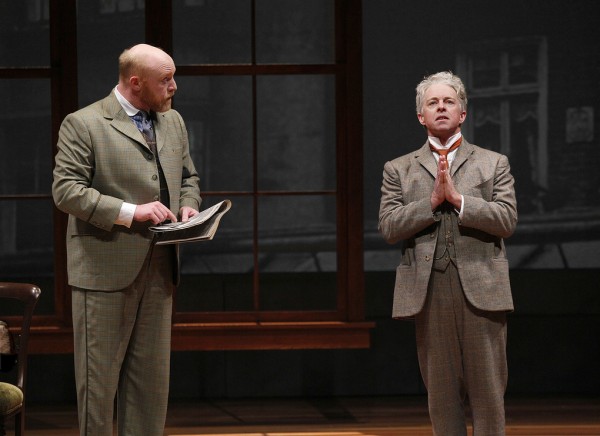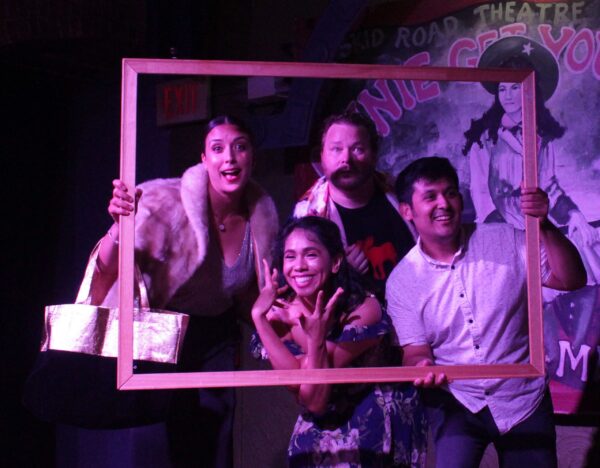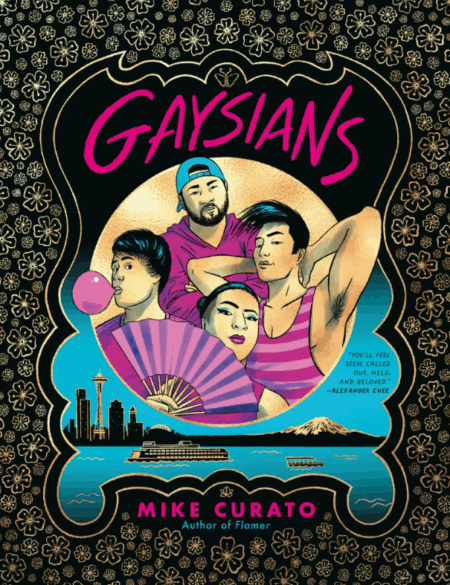So much crime on Seattle stages this week…and, it’s all vaguely Victorian to one degree or the other.
Two local theater companies, one very big and the other quite small are staging melodramatic plays featuring murder, theft, skullduggery and corsets. Both have their charms…though, one more than the other.

Andrew McGinn (Dr. John Watson) and Darragh Kennan (Sherlock Holmes) in Seattle Repertory Theatre’s “Sherlock Holmes and The American Problem.
Review: Sherlock Holmes and The American Problem by R. Hamilton Wright. Inspired by characters created by A. Conan Doyle. Produced by Seattle Repertory Theatre. Directed by Alison Narver. With Tim Gouran, Darragh Kennan, Christine Marie Brown, Alex Matthews, Marianne Owen, Andrew McGinn, Cheyenne Casebier, Charles Leggett, Rob Burgess. Now through May 22, 2016 at Seattle Rep.
We’ll start with the one that probably has a wig budget equal to the entire budget of the smaller theater company’s show…Seattle Rep has returned to the Victorian world of Sherlock Holmes, with the world premiere of the original work, Sherlock Holmes and The American Problem, a follow up to their hugely popular production of The Hound of the Baskervilles from a couple years back. That adaption of the novel by A. Conan Doyle was done by local Seattle actors R. Hamilton Wright and David Pichette and starred Darragh Kennan as Holmes, Andrew McGinn as Watson, Marianne Owen as Mrs. Hudson with Rob Burgess and Charles Leggett as part of the large ensemble and was directed by Alison Narver. The mostly faithful adaptation of the beloved tale, was both a critical and commercial success with much praise for the production’s exquisite design work from L.B. Morse (sets/lights/projections), Deb Trout (costumes) and Paul James Prendergast (sound/music).
The success of that production led the Rep to commission a new Holmes play and most of the team returned with a few exceptions. David Pichette bowed out of writing duties and Obadiah Eaves replaced Mr. Prendergast as Sound Designer/Composer. This time, Mr. Wright decided to forgo adapting an existing Doyle work to write an entirely new and original story for Holmes and Watson. The result is, Sherlock Holmes and The American Problem which find our heroes in 1887 as London and the world prepare to celebrate the Golden Jubilee of Queen Victoria. But, the influx of tourists to London, especially many Americans including Buffalo Bill and Mark Twain, is vexing the cranky Holmes who has just been handed an odd commission by a visiting American woman named Miss Phoebe Anne Moses…would the famed detective aid her in finding out what had happened to her black sheep brother who had left America for London several years prior but had then vanished without a trace?
Holmes is reluctant to take the case as he has his hands full with a surprisingly large number of mysteries to solve involving missing drilling equipment, suspicious bank clerks, a bakery with odd hours, and a large amount of criminal activity that may or may not be forming a pattern. Then, there’s the odd behavior of Sherlock’s estranged brother Mycroft and the fact that Miss Phoebe Anne Moses isn’t the woman she claims to be….
And, that’s the chief problem with this play… Sherlock Holmes and The American Problem has far too many plots to follow and not enough logic. There’s a scene where Holmes humorously uses a ball of twine to illustrate how everything supposedly connects and while we wait for it to all unravel in that usual Holmesian way we’ve come to expect, that never really happens….we’re just left with a knotted mass of twine wrapped around a lot of loose ends and rather annoying red herrings. Mr. Wright has made the mistake of thinking he could craft a better Sherlock Holmes story than A. Conan Doyle. He can’t. Plotting any mystery tale is a tricky business; there’s a lot to keep track of and even the great mystery writers have floundered at times. The 32 “unusual coincidences” that propel this story are never satisfyingly explained. Holmes attempts to wrap it all logically in a long and rather dull anti-climatic final scene but honestly, you can sense the actors don’t even believe the ridiculous things coming out of their mouths.
And, there’s a lot of explanation and dialogue in “The American Problem”…too much. There are times where the characters just blather on endlessly instead of getting on with the business of the story. The sloppiness of the script and plot then in turn affects the direction of the play…while Alison Narver’s staging of “Baskervilles” was taut and visually stimulating, here she has to deal with too much deadwood dialogue and so many redundant scenes set at 22 Baker Street, the home base for Holmes and Watson. (Also: an annoying running gag involving Mrs. Hudson and the coffee that ran itself into the ground quite quickly….) There are exciting moments here and there in “The American Problem” particularly a terrific chase and fight scene that must have been staged with the help of fight director Rick Sordelet that’s also largely aided by L.B. Morse and his once again fantastic set/lighting/projection design. It was a stunning bit of theater craftsmanship in a night that needed more of them.
The chief highlights of this play are all visual with Mr. Morse’s work leading the way along with Deb Trout’s once again delightful costumes as well as fine work from Obadiah Eaves with sound design and music composition. (Though his main theme DID sound a lot like the theme to “Downton Abbey”….)
The actors are a treat, too, though Mr. Kennan’s “funny” Holmes might not delight all Doyle purists. His Holmes is more exasperated (and exasperating) than other portrayals of the detective but it’s all very crowd pleasing. Andrew McGinn’s Watson is appropriately stolid and slightly dim and Marianne Owen makes the best of Mrs. Hudson, a character with not much to do other than make cold coffee.
Other actorly delights: Christine Marie Brown as the mysterious Phoebe Anne Moses. Her broad Ohioan accent was particularly delightful. Alex Matthews was great fun as a Pinkerton Agent while Cheyenne Casebier seemed to be HAVING a lot of fun playing two very different characters.
There are great things onstage at the Rep with Sherlock Holmes and The American Problem including the actors and the design work and at times it’s great fun but the play itself is just not very good. If the Rep and Mr. Wright wish to return to the Land of Sherlock Holmes, please also return to the Land of A. Conan Doyle for your plot.
Review: A Hand of Talons by Maggie Lee. Produced by Pork Filled Productions. Directed by Amy Poisson. With Jenn Ruzumna, Stephanie Kim-Bryan, Ben Burris, Sean Schroeder, Kenna Kettrick, Mariko Kita, Tim Gagne, Abhijeet Rane. Now through May 21, 2016 at Theatre Off Jackson.
Down in the International District’s Theatre Off Jackson, there’s a different kind of murder mystery afoot. It’s sorta/kinda Victorian as well, but we’re in the fantasy world of Steam Punk and anime with Pork Filled Productions and their current show, A Hand Of Talons by Maggie Lee. It’s the latest in Ms Lee’s series of plays set in her “New Providence” universe that have so far included The Tumbleweed Zephyr and The Clockwork Professor (also produced by Pork Filled Productions), an alterna-verse that’s a twisted mix of the modern and the past, most specifically a late 19th/early 20th century world populated by competing clans all vying for control of the “New World” while dealing with the long arm of “The Old World”.
“Talons” centers on the Yao Clan which is headed by the fierce Delphine Yao who tries to wield control over her rather insubordinate younger siblings, the petulant brother Anders and free spirited sister Wilhemina who owns Fortuna Mews, the gambling house where our story is set….the title “A Hand of Talons” refers to the highest winning hand in a popular card game in the New Providence world. Wilhemina runs her house with the aid of the loyal Bernadette, who’s no fan of Delphine, and Lawrence Howell, a man of no family but great integrity who not so secretly loves Wilhemina.
Howell is chagrined to discover that Wilhemina has fallen for a visiting member of the Old World Yao Clan, Kenzo Yao, a smooth talking charmer who woos his way into Wilhemina’s heart while attracting the suspicions of Lawrence, Bernie, Anders, Delphine and Delphine’s loyal lieutenant, Lin Curtis. Eventually, relationships are tested, between family and friends, as the Yao Clan fights for its survival in a harsh world.
A Hand of Talons is a very clever play. Maggie Lee has done an exceptional job of creating a very layered, intricate and complex world. But, she’s also managed to make this world accessible to the casual viewer. You don’t need to have seen the other plays set in this world to enjoy and understand “Talons”. Lee has created a complex world but to any fan of this genre of literature, it’s clear and concise. It’s a broadly drawn, melodramatic world of violent passions and emotions; if you’re looking for subtle, low key drama, this isn’t the show for you. “Talons” is a fantasy world and is probably best enjoyed by fans of that kind of material. Fortunately, there are millions of genre fans out there who would enjoy this kind of anime driven theater.
It’s also a handsome production with some very impressive design work including its only set, the Fortuna Mews office which naturally features Asian design elements including the use of sliding screens and a hidden, secret door. It’s a superb design from Brandon Estrella and probably even more impressive considering Pork Filled Productions doesn’t have massive amounts of money to spend. (It’s the kind of set you’d like to live in.) Equally rich looking are the gorgeous steampunked fashions by Jocelyne Fowler. Not to mention the evocative lighting design by Tess Malone and sound design by Joseph Swartz. It’s a fantastic looking/sounding production.
“Talons” is also well staged by director Amy Poisson with some superb fight choreography from May Nguyen. Unlike “Sherlock Holmes”, this production is perfectly paced.
There’s also some strong acting talent on that stage led by Stephanie Kim-Bryan’s work as the central figure Wilhemina. Ms Kim-Bryan does a terrific job of growing her character over the course of the two acts/two hours of the play. Wilhemina starts as a bit immature and flighty but by the end of the play, she’s a strong leader. It’s a very assured confident performance.
She’s aided by the charms of Ben Burris as her pining beau, Lawrence and Sean Schroeder as her bratty brother Anders. Mariko Kita as the formidable sister/leader adds much welcomed feminine strength to the proceedings….it’s nice to see a play featuring so many strong female characters.
A Hand of Talons isn’t for everyone. If you’re not a fan of this genre (fantasy/anime/adventure) you’re probably not going to “get” this play. If you like entering mysteriously clever new worlds, then A Hand of Talons is a must see event.

















